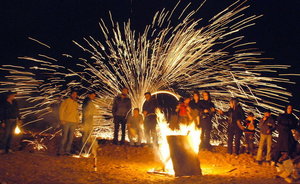Persian New Year (Nowruz) is upon us. Today, March 20th, Persians will celebrate the New Year. Nowruz marks the first day of spring, the equinox, and the beginning of the year in the Persian calendar. Nowruz is celebrated by many different ethnic communities and religious backgrounds. Though it is a secular holiday, Zoroastrians hold it as a holy day for themselves. Nowruz is primarily celebrated in Iran, Afghanistan, Azerbaijan, the North Caucasus, Kurdish areas in the Middle East, Tajikistan, Turkmenistan, Uzbekistan, Kyrgyzstan, Kazakhstan, and other areas in central and south Asia. The holiday has been celebrated for over 3000 years and today marks the beginning of the year 1394. In 2010, the UN recognized the International Day of Nowruz, describing it as a spring festival of Persian origin.
Nowruz is a time for family and friends to gather and celebrate. In Iran, children typically have a fourteen-day vacation from school, and most adults do not work during the Nowruz festivities. The Wednesday before the New Year is celebrated with a feast called Chaharshanbe Suri. During this time, people traditionally gather and light small bonfires in the streets and jump over the flames shouting “Zardie man az to, sorkhie to az man” which means “May my sickly pallor be yours and your red glow be mine.” People mention these colors because symbolically, red means good luck and yellow means illness. The flames are said to take away all of the unpleasant things that happened in the past year.
The most important part of the celebration is the haft-seen table. Creating the haft-seen table is a family activity that begins by spreading a special family cloth on the table, then placing the seven “S” items that symbolize Nowruz.
- Somagh (sumac): symbolizes the color of sunrise
- Serkeh (vinegar): symbolizes age and patience
- Senjed (dried fruit from lotus tree): symbolizes love
- Samanoo (sweet pudding): symbolizes affluence
- Sabzeh (sprouts): symbolizes rebirth
- Sib (apple): symbolizes health and beauty
- Sir (garlic): symbolizes medicine

In addition to these “S” items, other symbolic items go on the haft-seen table. For example, it is customary to place a mirror on the table to symbolize reflection on the past year. Each family may also place other items on the table that are special to them. The haft-seen table remains in the family home for thirteen days after the beginning of Nowruz. The thirteenth day is called Sizdeh Bedar, which literally means “getting rid of the thirteenth.” The festival that takes place on Sizdeh Bedar is similar to the start of Nowruz.
Nowruz is one of the oldest celebrated traditions in the world that continues to be enjoyed today. To all of those that are celebrating, Nowruz Mabaark! 



